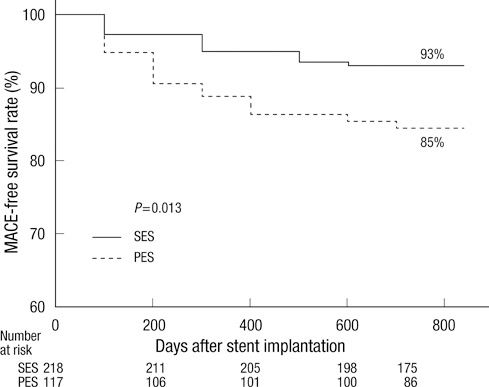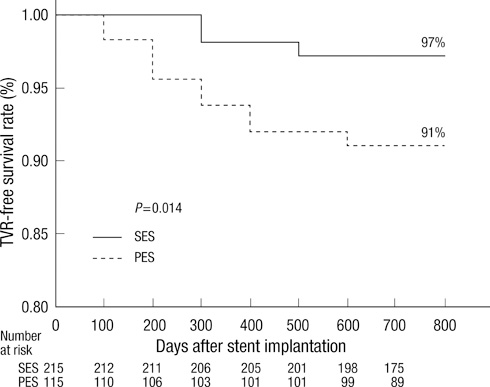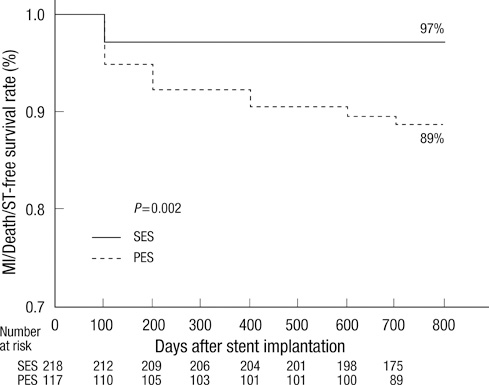J Korean Med Sci.
2011 Oct;26(10):1299-1304. 10.3346/jkms.2011.26.10.1299.
Two-year Clinical Outcomes of Patients with Long Segments Drug-Eluting Stents: Comparison of Sirolimus-Eluting Stent with Paclitaxel-Eluting Stent
- Affiliations
-
- 1Division of Cardiology, Department of Internal Medicine, Yeungnam University Medical Center, Daegu, Korea. pjs@med.yu.ac.kr
- 2Division of Cardiology, Department of Internal Medicine, Inje University Busan Paik Hospital, Busan, Korea.
- 3Division of Cardiology, Department of Internal Medicine, Inje University Haeundae Paik Hospital, Busan, Korea.
- 4Division of Cardiology, Department of Internal Medicine, Keimyung University Dongsan Hospital, Daegu, Korea.
- KMID: 1785986
- DOI: http://doi.org/10.3346/jkms.2011.26.10.1299
Abstract
- Limited data are available on the long-term clinical efficacy of drug-eluting stent (DES) in diffuse long lesions. From May 2006 to May 2007, a total of 335 consecutive patients (374 lesions) were underwent percutaneous coronary intervention with implantation of long DES (> or = 30 mm) in real world practice. Eight-month angiographic outcomes and 2-yr clinical outcomes were compared between SES (n = 218) and PES (n = 117). Study endpoints were major adverse cardiac events including cardiac death, myocardial infarction, target-lesion revascularization, target-vessel revascularization and stent thrombosis. Baseline characteristics were similar in the two groups as were mean stent length (44.9 +/- 15.2 mm in SES and 47.4 +/- 15.9 in PES, P = 0.121). Late loss at 8 months follow-up was significantly lower in SES than in PES group (0.4 +/- 0.6 mm in SES vs 0.7 +/- 0.8 mm in PES, P = 0.007). Mean follow-up duration was 849 +/- 256 days, and 2-yr cumulative major adverse cardiac events were significantly lower in the SES than in the PES group (5.5% in SES vs 15.4% in PES, P = 0.003). In conclusion, long-term DES use in diffuse long coronary lesions is associated with favorable results, with SES being more effective and safer than PES in this real-world clinical experience.
MeSH Terms
Figure
Reference
-
1. Morice MC, Serruys PW, Sousa JE, Fajadet J, Ban Hayashi E, Perin M, Colombo A, Schuler G, Barragan P, Guagliumi G, Molnàr F, Falotico R. RAVEL Study Group. Randomized Study with the Sirolimus-Coated Bx Velocity Balloon-Expandable Stent in the Treatment of Patients of Patients with de Novo Native Coronary Artery Lesions. A randomized comparison of a sirolimus-eluting stent with a standard stent for coronary revascularization. N Engl J Med. 2002. 346:1773–1780.2. Degertekin M, Serruys PW, Foley DP, Tanabe K, Regar E, Vos J, Smits PC, van der Giessen WJ, van den Brand M, de Feyter P, Popma JJ. Persistent inhibition of neointimal hyperplasia after sirolimus-eluting stent implantation: long-term (up to 2 years) clinical, angiographic, and intravascular ultrasound follow-up. Circulation. 2002. 106:1610–1613.3. Kobayashi Y, De Gregorio J, Kobayashi N, Akiyama T, Reimers B, Finci L, Di Mario C, Colombo A. Stented segment length as an independent predictor of restenosis. J Am Coll Cardiol. 1999. 34:651–659.4. Foley DP, Pieper M, Wijns W, Suryapranata H, Grollier G, Legrand V, de Scheerder I, Hanet C, Puel J, Mudra H, Bonnier HJ, Colombo A, Thomas M, Probst P, Morice M, Kleijne J, Serruys PW. MAGIC 5L Investigators. The influence of stent length on clinical and angiographic outcome in patients undergoing elective stenting for native coronary artery lesions: final results of the Magic 5L Study. Eur Heart J. 2001. 22:1585–1593.5. de Feyter PJ, Kay P, Disco C, Serruys PW. Reference chart derived from post-stent-implantation intravascular ultrasound predictors of 6-month expected restenosis on quantitative coronary angiography. Circulation. 1999. 100:1777–1783.6. Cutlip DE, Windecker S, Mehran R, Boam A, Cohen DJ, van Es GA, Steg PG, Morel MA, Mauri L, Vranckx P, McFadden E, Lansky A, Hamon M, Krucoff MW, Serruys PW. Academic Research Consortium. Clinical end points in coronary stent trials: a case for standardized definitions. Circulation. 2007. 115:2344–2351.7. Cook S, Wenaweser P, Togni M, Billinger M, Morger C, Seiler C, Vogel R, Hess O, Meier B, Windecker S. Incomplete stent apposition and very late stent thrombosis after drug-eluting stent implantation. Circulation. 2007. 115:2426–2434.8. Ellis SG, Vandormael MG, Cowley MJ, DiSciascio G, Deligonul U, Topol EJ, Bulle TM. Multivessel Angioplasty Prognosis Study Group. Coronary morphologic and clinical determinants of procedural outcome with angioplasty for multivessel coronary disease. Implications for patient selection. Circulation. 1990. 82:1193–1202.9. Wessely R, Kastrati A, Schömig A. Late restenosis in patients receiving a polymer-coated sirolimus-eluting stent. Ann Intern Med. 2005. 143:392–394.10. Windecker S, Remondino A, Eberli FR, Juni P, Räber L, Wenaweser P, Togni M, Billinger M, Tuller D, Seiler C, Roffi M, Corti R, Sütsch G, Maier W, Lüscher T, Hess OM, Egger M, Meier B. Sirolimus-eluting and paclitaxel-eluting stents for coronary revascularization. N Engl J Med. 2005. 353:653–662.11. Lee CW, Park KH, Kim YH, Hong MK, Kim JJ, Park SW, Park SJ. Clinical and angiographic outcomes after placement of multiple overlapping drug-eluting stents in diffuse coronary lesions. Am J Cardiol. 2006. 98:918–922.12. Kim YH, Park SW, Lee SW, Park DW, Yun SC, Lee CW, Hong MK, Kim HS, Ko JK, Park JH, Lee JH, Choi SW, Seong IW, Cho YH, Lee NH, Kim JH, Chun KJ, Park SJ. Long-DES-II Study Investigators. Sirolimus-eluting stent versus paclitaxel-eluting stent for patients with long coronary artery disease. Circulation. 2006. 114:2148–2153.13. Chu WW, Kuchulakanti PK, Torguson R, Wang B, Clavijo LC, Suddath WO, Pichard AD, Satler LF, Kent KM, Waksman R. Impact of overlapping drug-eluting stents in patients undergoing percutaneous coronary intervention. Catheter Cardiovasc Interv. 2006. 67:595–599.14. Ruchin PE, Trabattoni D, Fabbiocchi F, Montorsi P, Lualdi A, Ravagnani P, Grancini L, Galli S, Teruzzi G, Calligaris G, De Martini S, Bartorelli AL. Use of multiple overlapping sirolimus-eluting stents for treatment of long coronary artery lesions: results from a single-center registry in 318 consecutive patients. Int J Cardiol. 2009. 134:231–237.
- Full Text Links
- Actions
-
Cited
- CITED
-
- Close
- Share
- Similar articles
-
- Very Late Stent Thrombosis Related to Fracture of a Sirolimus-Eluting Stent
- A Case of Stent Strut Fracture of a Paclitaxel-Eluting Stent at the Time of Stent Implantation in a Complex Coronary Lesion
- Drug-Eluting Stent Strut Fracture as a Cause of Restenosis
- A Case of Stent Thrombosis Occurred at 5 Years after Sirolimus-Eluting Stent Implantation
- Dark Side of Drug-eluting Stent in Contemporary Percutaneous Coronary Intervention




